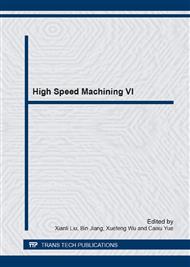p.167
p.175
p.180
p.186
p.191
p.197
p.203
p.208
p.214
Experimental Study on Turning Nickel-Based Superalloy GH4033 with Coated Cemented Carbide Tools
Abstract:
The nickel-based superalloy GH4033 is one of the difficult-to-cut materials. In order to investigate the machinability of GH4033, the tool cutting performance, tool failure modes, tool life and the relationships between surface roughness and tool flank wear were studied by using different coated cemented carbide cutting tools under dry cutting. Aiming at the amount of metal removal combining with the tool life and surface quality, the better cutting tool coating type and optimal cutting parameters were obtained through the orthogonal experiments. The results showed that the cutting performance of TiCN coated tool (GC4235) was better than that of TiAlN coated tool (JC450V). With these two kinds of tools, the machined surface roughness decreased to a minimum value and then increased with the increase of flank wear. When cutting GH4033, the main wear mechanism for both of the two types of tools included adhesive wear, diffusive wear, abrasive wear, edge wear and coating peeling.
Info:
Periodical:
Pages:
191-196
Citation:
Online since:
July 2014
Authors:
Price:
Сopyright:
© 2014 Trans Tech Publications Ltd. All Rights Reserved
Share:
Citation:


